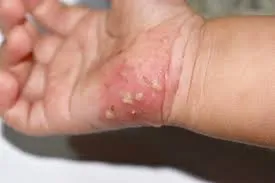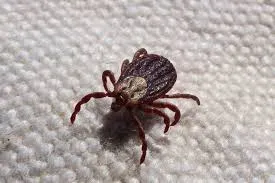Scabies is an infectious disease caused by the parasitic mite Sarcoptes scabiei. Therefore, this disease is often called scabies disease. This disease is highly contagious and causes itching in sufferers.
In these cases, the tiny mites that cause scabies burrow into the skin and lay their eggs in the layers of human skin. Scabies is a worldwide disease and can affect anyone from any ethnicity and race. People with clean habits and appearance can even get this disease.
This disease is spread by direct skin-to-skin contact. The main symptom is itching that is excruciating and occurs continuously.
Scabies is indeed more common in developing countries or countries with tropical climates. However, it is possible that this disease is found in developed countries with cold climates. This can happen because the spread of scabies is not determined by the air, but through direct physical contact with the sufferer.
that is what then makes scabies often categorized as a sexually transmitted disease. If you have sex with a person with scabies and touch the skin or an area affected by scabies, you may also become infected.
Transmission through sexual intercourse mainly occurs in patients who are at the age of active sexual intercourse. However, that does not mean the spread of scabies can only be through sexual intercourse.
Most people are not aware of having this disease in its early stages. This is because the symptoms are very similar to other skin infections, such as acne or mosquito bites. At a later stage, then scabies is easily recognized by its painful itching.
Symptoms that arise are skin rashes in the form of red bumps and blisters that affect certain parts of the sufferer's skin. Another symptom is the appearance of small red tunnels in the skin folds accompanied by itching. The itchy feeling on the skin will eventually cause the sufferer to frequently scratch the affected skin so that it can cause additional infection due to the scratching wound.
Symptoms of scabies often appear up to six weeks after the first scabies infection occurs. In patients who have previously been infected, symptoms can usually appear in a shorter time.
The main symptom of scurvy is a red rash accompanied by excessive itching and it gets worse, especially at night. Wounds caused by continuous scratching of the skin can cause blisters which in turn cause additional infections of the skin, namely infections caused by other bacterial causes. If an additional infection has occurred, the doctor will usually recommend giving additional antibiotics to the skin.
The most common symptom of scabies is intense itching, as well as a painful, itchy rash. Since it is a sexually transmitted disease, scabies can also be found on the genitals, usually the penis.
Scurvy can also occur in infants, toddlers, and sometimes at an advanced age. People with compromised immune conditions may also be infected with scabies with symptoms of a rash and itching that appear on.
Symptoms of scabies in the form of a rash on the skin usually consists of small blisters or blisters. The rash that appears can be in the form of small red spots, reddish bumps and large bruise-like bumps.
Sometimes, tunnels or small holes can be found which are nests for scabies mites on the sufferer's skin. These burrows are usually straight-line bumps that are a different color than the healthy area of skin.
Small holes may be visible above the rash as they are tunnels made by the female flea to deposit her eggs. However, the number of ticks on the skin is usually very limited. Only 10 to 15 ticks per person. This is what makes the tunnel where the flea eggs are stored is difficult to find.
Some sufferers may also have the skin disorder of scurvy called Norwegian Scabies or scabies ulcers. Scurvy is more severe and highly contagious. Sufferers appear to have thick ulcers on the skin containing thousands of scabies lice and nits.
The cause of scabies is a parasite or female flea called Sarcoptes scabiei. Therefore, this disease is often called scabies or human fleas. These parasites live on the skin and burrow into the top layer of skin to deposit their eggs. After three or four days, flea larvae will hatch and move to the surface of the skin to grow to maturity.
During its life, Sarcoptes scabiei undergoes four cycle stages, namely the egg, larva, nymph, and adult stages. The female scabies parasite will lay 2 to 3 eggs per day, while continuing to dig tunnels in human skin. Then these eggs will hatch after three to four days.
After the eggs hatch, the scabies larvae will migrate to the surface of the skin, dig tunnels, and nest in the skin layers. After that, the larva develops into a nymph and then becomes an adult flea. As adults, male fleas will find female fleas and breed repeating the same life cycle.
Transmission of this disease occurs mainly due to the transfer of female fleas that have been fertilized by male fleas through skin contact between one person and another.
Scabies can appear anywhere on the body. However, the favorite places of the Sarcoptes scabiei parasite are warm places on the surface layer of the skin. Therefore, scabies are often found on the skin between the fingers, breast folds, waistline, and also under the nails.
The Sarcoptes scabiei parasite also often hides under bracelets, rings or watch bands on human skin. Even though humans only have the potential to have 10 to 15 Sarcoptes scabiei mites, this one parasite is still difficult to find and eradicate from the skin because its size is no more than half a millimeter.
Scabies mites cannot jump or fly. The way they move is by creeping slowly. Because of that, the only way for them to move from one person to another is to wait for these people to have intense physical contact.
This is why scabies is said to be a sexually transmitted disease, because sex is an example of intense physical contact that lasts a long time. Also avoid using the same items with people with scabies. There is a potential for you to catch it because the scabies mite can live outside the human body for 24 to 36 hours.
This disease occurred a few months ago to my child which I was very overwhelmed in treating him for almost 1 year.
let's take care of our health and that of our children because we can't see infectious diseases but let's eradicate them together.
Best Regards
By @lingkar-photo

